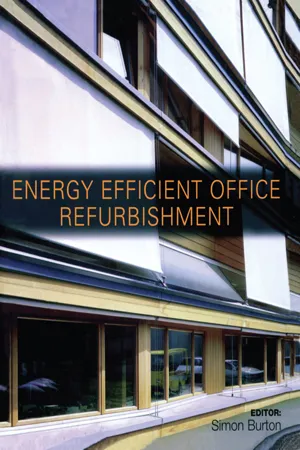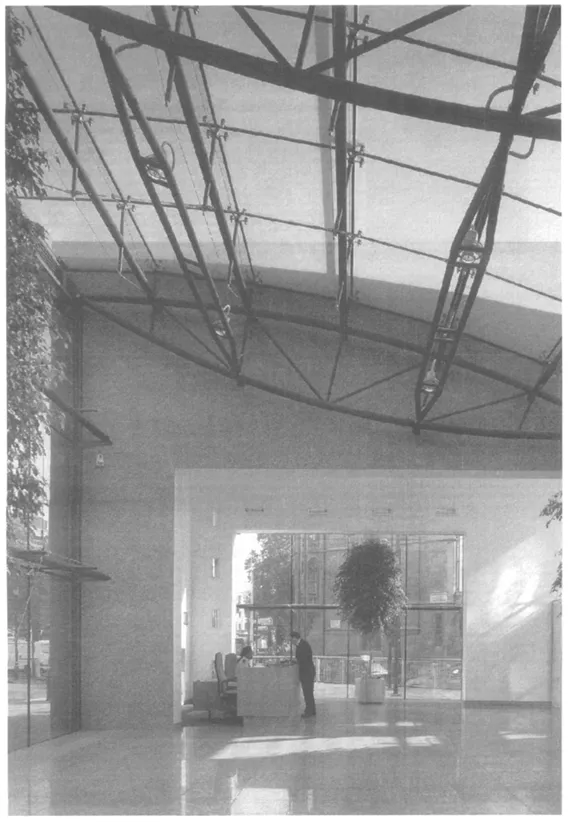![]() Part I
Part I
The Handbook![]()
1
Introduction
1.1 European Office Buildings
Office buildings provide the working environment for a large and increasing proportion of the European workforce. There is considerable diversity in the type and location of buildings used as offices throughout Europe, with new buildings being constructed and existing buildings renovated (Chapter 2). The principal requirement of office buildings is to provide comfortable, healthy and productive conditions for the workers, however costs, both capital and running, play an increasingly important part in decision-making for design, fitting out, etc. With increasing international concern about energy use and its environmental consequences, another dimension is becoming increasingly important, that of energy consumption in offices and the consequent production of carbon dioxide, and other ways in which offices can affect the local and global environments.
Energy is commonly used in offices for many activities, including heating, ventilation, cooling, lighting, equipment and catering. However, electrical and fossil fuel energy consumption can be reduced by the use of natural or solar energy for functions such as lighting, heating and passive ventilation, and can even be the host for the generation of electricity via photovoltaic arrays or for active solar water heating. Thus the design of an office building will have a large effect on its consumption of energy in use (Chapter 2). The size of the office sector compared with other users of energy, make this a highly significant area in which to take action to reduce global energy consumption.
1.2 Office Refurbishment
Existing offices undergo refurbishment from time to time, to upgrade the internal (and external) environment, to provide more modern accommodation and to attract new owners or tenants, refurbishment providing an alternative to demolition and construction of a new building. From a wide environmental perspective, refurbishment can be seen as a better option than demolition and rebuilding, although the basic building structure and the design and quality of the refurbishment will affect the overall environmental balance between refurbishment and demolition. Many factors must be taken into account, including demolition effects, construction energy including embodied energy of materials, subsequent energy use during the lifetime of the building, the quality of the internal environment produced, etc. On the other hand, refurbishment may simply be cheaper than demolition, may avoid planning restrictions on new developments and may make general economic sense.
Refurbishment of buildings is also undertaken to maintain historic buildings in active use and preserve historic areas, increasingly considered an important part of European heritage.
Apart from major refurbishment when an office approaches the end of its life, partial upgrading is used at intervals to improve conditions and/or performance, of which energy use may be an important component.
Any refurbishment provides the opportunity to improve the energy and environmental performance of offices and this can be achieved in a number of ways (Chapter 3).
1.3 Energy and Comfort in Offices
Energy use and internal environmental quality must be considered together in offices. Energy use is frequently seen as a prerequisite for the required comfort conditions for occupants, but a design using passive techniques and natural forces can produce a good internal environment at very low energy cost. The European IAQ study1 showed that there is no correlation between overall energy use and comfort.
Figure 1.1. The foyer of the refurbished offices of the Department of Trade and Industry (DTI), London
New buildings are frequently thought to provide more prestigious and efficient offices than older buildings. This need not be true if a refurbishment scheme is designed to provide the internal conditions expected in modern offices. In fact, in many cases refurbishment may provide generally higher standards than typical in new constructions, due to more generous space standards or use of higher quality materials. It is the quality of design, linked with the knowledge of how buildings operate, that will determine the final quality and energy consumption of an office, rather than whether it is a new or old building.
There are basically two different approaches to achieving good internal conditions in an office – using natural forces as far as possible, or relying on mechanical equipment. Natural methods include daylighting, insulation, solar gain, opening windows, solar shading, and cooling using thermal mass (Chapter 3). On the other hand, modern offices in many countries are built to rely on artificial lighting, heating, cooling and ventilation using mechanical equipment and sophisticated automatic control systems, and this trend also affects refurbishment. The energy consumption of offices with sophisticated mechanical systems is always many times higher than that of climate respecting buildings which minimize such equipment by the use of natural forces. In practice, many buildings rely on a mixture of natural forces and mechanical systems and, with careful design, a ‘mixed system’ can give the best internal conditions with low energy use.
However it must be remembered that ‘comfort’ can be defined in a number of ways and has different meanings to different people. Whilst an air – conditioned office can provide temperatures within a closely defined range (typically 19 to 22°C), a naturally ventilated office will have much higher temperatures in summer, though the effects of an open window and moving fresh air can make these equally or more acceptable. Similarly, an artificially lit office with tinted windows to reduce glare and solar gain will provide a consistent light level, but the changing light levels and clear views from a daylit office may provide a more pleasant and stimulating environment. Some research has demonstrated the importance to a person’s perceived level of comfort, of individual control over the local environment, a concept becoming known as ‘adaptive opportunities’.
1.4 Other Environmental Issues in Offices
The global environmental effects of energy consumption are not the only important environmental issues connected with new and refurbished offices. Environmental effects can be identified at global, local and indoor levels and design of both new buildings and refurbishment projects can reduce their negative impact. Particularly important in refurbishment are indoor air quality, day lighting and views from windows, glare, noise and humidity. At the ‘local’ level issues include the risk of Legionnaire’s disease from wet cooling towers, water conservation, cycling facilities and access to public transport. At the ‘global’ level, emissions of NOx from boilers contributing to acid rain, the avoidance of ozone depleting substances and providing space for recycling of waste materials should be borne in mind.
1.5 Background to the Handbook
This book has been produced as part of the output from a European multi-country project, ‘Passive retrofitting of office buildings to improve their energy performance and indoor working conditions’, supported by a JOULE grant from the European Commission DGXII. Other reports and working documents are available. During the project, ten existing offices were chosen to represent as far as possible the diversity of office buildings found in Europe. These are described in Chapter 2. Monitoring of energy use and internal conditions was carried out over a one-year period and the data were analysed to validate computer modelling of each building.
Various retrofitting measures and packages of measures appropriate to each building were modelled to analyse the effects on energy consumption and internal comfort. The emphasis was on passive measures but packages also included improvements to mechanical services as necessary and appropriate. The design and costs of the various measures were explored to assess the practical applications and the most cost-effective measures.
The results of these analyses have been used to put together design guidance for architects and engineers on passive retrofit strategies and technologies. Chapter 3 discusses how the designer should approach refurbishment to minimize energy use whilst providing good internal conditions for occupants, and emphasizes the ‘passive’ opportunities. Each issue, such as heating, lighting, ventilation, etc., is dealt with separately and explanations of the theory behind the recommendations are given as appropriate.
In order to assess the changes in energy consumption and comfort produced by the refurbishment packages and to be able to compare different buildings (in different countries) an ‘overall rating methodology’ has been developed (Chapter 6).
In Part II of the book, each of the ten buildings s...

